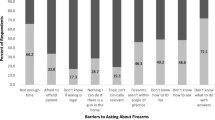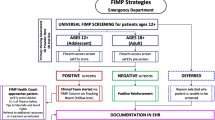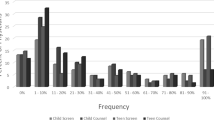Abstract
Preventive medicine plays a central role in the reducing the number of deaths due to preventable causes of premature deaths. General Preventive Medicine Residency programs have not been studied in relation to training in this area. A three-wave mail survey was conducted with email and telephone follow-ups. The outcome measures were the portion of program directors involved in training residents on firearm injury prevention issues and their perceived benefits and barriers of training residents on firearm injury prevention issues. Only 25% of the programs provided formal training on firearm injury prevention. Program directors who provided formal training perceived significantly higher number of benefits to offering such training than did directors who did not provide such training but no significant difference was found between the two for number of perceived barriers. If preventive medicine residency graduates are to play a role in reducing premature morbidity and mortality from firearms it will require more residencies to offer formal training in this area. The Association for Prevention Teaching and Research needs to develop guidelines on specific curriculum topics regarding firearm injury prevention.
Similar content being viewed by others
References
Mokdad, A. H., Marks, J. S., Stroup, D. F., & Gerberding, J. L. (2004). Actual causes of death in the United States, 2000. Journal of the American Medical Association, 291, 1238–1245. (Errata, Journal of the American Medical Association 2005, 293–294).
Price, J. H., Murnan, J., Thompson, A. J., Dake, J. A., & Telljohann, S. K. (2005). Elementary school teachers’ involvement in firearm safety education. Journal of School Health, 75, 105–111.
Kellermann, A. L., & Reay, D. T. (1986). Protection or peril? An analysis of firearm-related deaths in the home. New England Journal of Medicine, 314, 1557–1560.
Bailey, J. E., Kellerman, A. L., Somes, G. W., et al. (1997). Risk factors for violent death of women in the home. Archives of Internal Medicine, 157, 777–782.
Miller, M., Azrael, D., & Hemenway, D. (2002). Rates of household firearm ownership and homicide across US regions and states, 1988–1997. American Journal of Public Health, 92, 1988–1993.
Kellermann, A. L., Rivara, F. P., Rushforth, N. B., et al. (1993). Gun ownership as a risk factor for homicide in the home. New England Journal of Medicine, 329, 1084–1091.
Kellermann, A. L., Somes, G., Rivara, F. P., et al. (1998). Injuries and deaths due to firearms in the home. Journal of Trauma, 45, 263–267.
Wiebe, D. J. (2003). Homicide and suicide risks associated with firearms in the home: A national case–control study. Annals of Emergency Medicine, 41, 771–782.
Wintemute, G. J. (2008). Guns, fear, the constitution, and the public’s health. New England Journal of Medicine, 358, 1421–1424.
Centers for Disease Control and Prevention. WISQARS (Web-based Injury Statistics Query & Reporting System). Accessed April 5, 2008, from http://www.cdc.gov/ncipc/wsqars.
Cook, P. J., & Ludwig, J. (2000). Gun Violence—the real costs (pp. vii–x). New York: Oxford University Press.
American Academy of Pediatrics, Committee on Injury, Poison Prevention. (2000). Firearm-related injuries affecting the pediatric population. Pediatrics, 105, 888–895.
American College of Physicians. (1998). Firearm injury prevention. Annals of Internal Medicine, 128, 236–241.
American Academy of Family Physicians. Firearms/handgun firearms, handguns and assault weapons. http://www.aafp.org/x6823.xml.
American Association of Orthopedic Surgeons. Firearms violence. http://www.aaos.org/wordhtml/papers/position/1134.html.
American Medical Association. H-145,000 firearms: Safety and regulation. http://www.ama-assn.org/apps/pf_online.
Committee on Trauma of the American College of Surgery. (2000). Statement on firearm injuries. Bulletin of the American College of Surgeons, 85, 24.
American College of Preventive Medicine. Residency directory at a glance. Accessed February 9, 2008, from http://www.acpm.org/education/residency/ataglance.htm.
American Medical Association. Fellowship and Residency Interactive Database (FREIDA). Accessed February 9, 2008, from http://www.ama-assn.org/ama/pub/category/2997.html.
Prochaska, J. O., DiClemente, C. C., & Norcross, J. (1992). In search of how people change: Applications to addictive behaviors. American Psychologist, 47, 1102–1114.
Janz, N., & Becker, M. (1984). The health belief model: A decade later. Health Education Quarterly, 11, 1–47.
Edwards, P., Roberts, I., Clarke, M., et al. (2002). Increasing response rates to postal questionnaires: Systematic review. British Medical Journal, 324, 1183–1187.
King, K. A., Pealer, L. N., & Bernard, A. L. (2001). Increasing response rates to mail questionnaires: A review of inducement strategies. American Journal of Health Education, 32, 4–15.
Price, J. H., Conley, P. M., & Oden, L. (1997). Training in firearm safety counseling in pediatric residency programs. Archives of Pediatric and Adolescent Medicine, 151, 306–310.
Price, J. H., Bedell, A. W., Everett, S. A., & Oden, L. (1997). Training in firearm safety counseling in family practice residency programs. Journal of Community Health, 22, 91–99.
The Liaison Committee on Medical Education (LCME). Current LCME accreditation standards. Accessed July 3, 2008, from http://www.lcme.org/standard.htm.
Author information
Authors and Affiliations
Corresponding author
Rights and permissions
About this article
Cite this article
Khubchandani, J., Price, J.H. & Dake, J.A. Firearm Injury Prevention Training in Preventive Medicine Residency Programs. J Community Health 34, 295–300 (2009). https://doi.org/10.1007/s10900-009-9156-6
Published:
Issue Date:
DOI: https://doi.org/10.1007/s10900-009-9156-6




